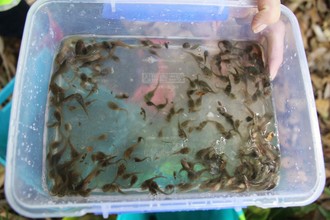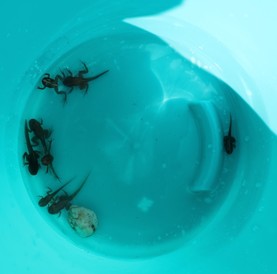The presence of frogs is a good indication of a healthy environment.
Frogs are cold-blooded animals that belong to a group of animals called amphibians. Usually, they start life as tadpoles in an aquatic (water) environment, and transform into frogs to become terrestrial (land-based) animals. Although frogs have lungs to breathe, they also breathe through their skin to regulate moisture and fluid transfer in a process called cutaneous gas exchange. Some frogs also cover their skin in a slimy substance (mucus) to protect the skin and keep it moist.
Despite their need to stay moist, frogs have adapted to an extraordinary range of environments, particularly in Australia. There are about 4000 frog species worldwide. Australia has 208 frog species, and many of these are endemic - that is, they are found nowhere else in the world. They may not be cute and cuddly but frogs are an important part of Australia's creeks, rivers and wetlands. If frogs start disappearing from the landscape, it is a sure sign that it's time to take better care of their watery homes.
Although a few Australian frog species, such as the green tree frog, are flourishing in human environments, many species have suffered dramatic population declines since the 1980s. Eight species of Australian frogs have become extinct in the last 25 years,* which means they have died out, and several more are likely to be extinct in the near future. Of particular concern is the disappearance of frogs from pristine habitats.
Despite their need to stay moist, frogs have adapted to an extraordinary range of environments, particularly in Australia. There are about 4000 frog species worldwide. Australia has 208 frog species, and many of these are endemic - that is, they are found nowhere else in the world. They may not be cute and cuddly but frogs are an important part of Australia's creeks, rivers and wetlands. If frogs start disappearing from the landscape, it is a sure sign that it's time to take better care of their watery homes.
Although a few Australian frog species, such as the green tree frog, are flourishing in human environments, many species have suffered dramatic population declines since the 1980s. Eight species of Australian frogs have become extinct in the last 25 years,* which means they have died out, and several more are likely to be extinct in the near future. Of particular concern is the disappearance of frogs from pristine habitats.
|
Frog life cycle
Many frogs reproduce by laying eggs in a mass of jelly like material in the water. Tadpoles develop from this jelly mass, rapidly grow arms and legs, lose their tails and eventually transform into frogs. Most tadpoles are unable to leave the water until they have developed into frogs. Others have far stranger ways of reproducing - some glue their eggs to underwater vegetation, while others hatch from the eggs as fully formed frogs. The male Hip-Pocket Frog carries tadpoles round in little pockets on his hips! |
Threats
The first evidence that Australian frog populations were in serious decline was provided by the disappearance of two species — the southern day frog and the gastric brooding frog. However, the urgency of the situation and the global nature of frog declines were not apparent until 1989. Although the factors responsible for the sudden fall in frog numbers are not clear, a number of human activities are harmful to frogs. Some of the most important include:
The first evidence that Australian frog populations were in serious decline was provided by the disappearance of two species — the southern day frog and the gastric brooding frog. However, the urgency of the situation and the global nature of frog declines were not apparent until 1989. Although the factors responsible for the sudden fall in frog numbers are not clear, a number of human activities are harmful to frogs. Some of the most important include:
- land reclamation by drainage in wetland areas, leading to loss of breeding sites
- the conversion of temporary ponds to dams for stock use, resulting in trampling by animals (such as cattle) and destruction of surrounding sheltering sites
- insecticide and herbicide use in agricultural and horticultural areas, particularly aerial spraying
- introduction of the mosquito fish, trout and other fish that prey on frog eggs and tadpoles
- increased salinity caused by land clearance (most frogs are salt intolerant)
- siltation from forestry operations.
Frog Chytrid fungus
The deadly Chytrid (pronounced 'ky-trid') fungus Batrachochytrium dendrobatidis is an infectious disease contaminating frogs worldwide, is also affecting many vulnerable species. The fungus can cause anything from sporadic deaths in some amphibian populations to 100% mortality in others.
The fungus attacks the parts of a frog's skin that have keratin in them. Since frogs use their skin in respiration, this makes it difficult for the frog to breathe. The fungus also damages the nervous system, affecting the frog's behaviour.
A sick frog may:
- have discoloured skin
- be sloughing, or peeling, on the outside layers of its skin - this can vary from obvious peeling of skin (particularly on the feet), to a roughness of the frog's skin that you can barely see
- sit out in the open, not protecting itself by hiding
- be sluggish, and have no appetite
- have its legs spread slightly away from itself, rather than keeping them tucked close to its body. In more extreme cases, the frog's body will be rigid, and its back legs will trail behind it.
|
Pollution
Ways of reducing the impact of pollution on frogs include:
You can help threatened frogs by:
|
For more information on frogs:
NB: Commercial trade in frogs is prohibited in NSW. There are commercial dealers in frogs in Victoria, South Australia, the Northern Territory and ACT. If you purchase an animal from one of these dealers, or from anyone else in another state, you must already hold a NSW amphibian keeper's licence and you must obtain an interstate import licence from the NPWS before you can legally bring it into NSW.
- Follow the herpetologists blogs on www.savethefrogs.com
- The Australian Amphibian Research Centre looks at issues such as captive breeding as well as education http://frogs.org.au/.
- Frogwatch USA is an innovative online data entry, mapping and analysis platform where anyone interested in frogs can explore practical strategies towards survival of the animals.
- Read the NPWS Hygiene Protocol for the Control of Disease in Frogs (644 KB PDF).
NB: Commercial trade in frogs is prohibited in NSW. There are commercial dealers in frogs in Victoria, South Australia, the Northern Territory and ACT. If you purchase an animal from one of these dealers, or from anyone else in another state, you must already hold a NSW amphibian keeper's licence and you must obtain an interstate import licence from the NPWS before you can legally bring it into NSW.
|
This material has been adapted and added to from:
‘Fact Sheet Frogs of Australia’ https://www.environment.gov.au/biodiversity/threatened/publications/factsheet-frogs-australia © Commonwealth of Australia 2016 |
|
And http://www.environment.nsw.gov.au/animals/ThreatsToFrogs.htm
© State of New South Wales and Office of Environment and Heritage 2015 |









